UNIT 10 CONNECTIONS LESSON 2 Community Spirit课件(共47张PPT,内镶嵌视频)高中英语北师大版(2019)选择性必修第四册
文档属性
| 名称 | UNIT 10 CONNECTIONS LESSON 2 Community Spirit课件(共47张PPT,内镶嵌视频)高中英语北师大版(2019)选择性必修第四册 | 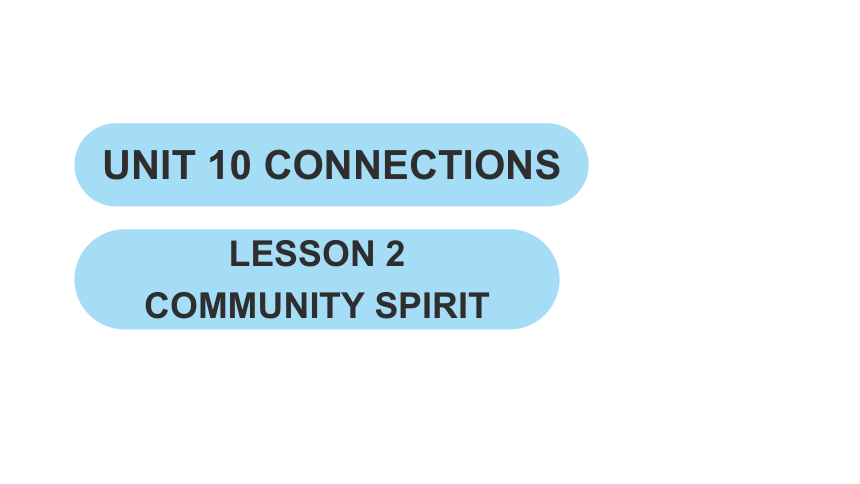 | |
| 格式 | pptx | ||
| 文件大小 | 27.2MB | ||
| 资源类型 | 教案 | ||
| 版本资源 | 北师大版(2019) | ||
| 科目 | 英语 | ||
| 更新时间 | 2025-04-01 19:36:10 | ||
图片预览

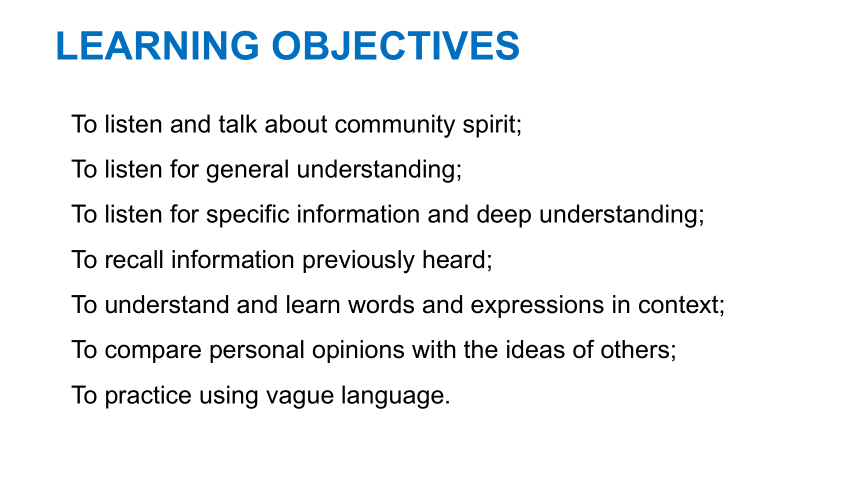
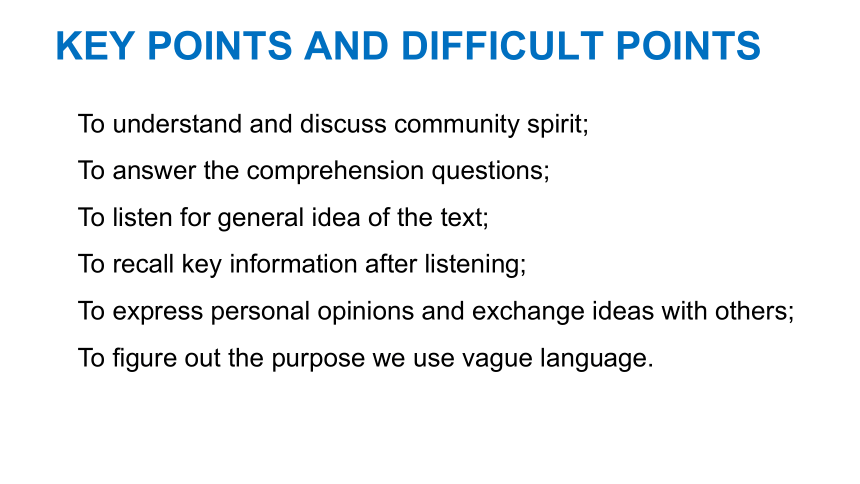
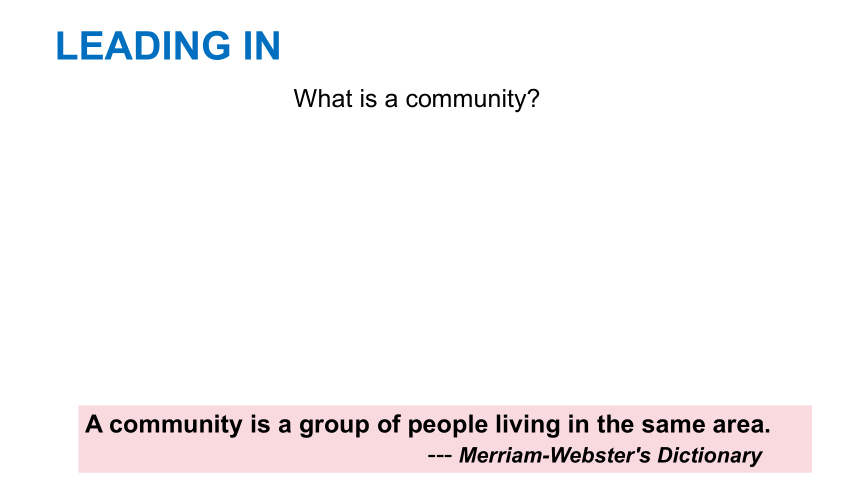

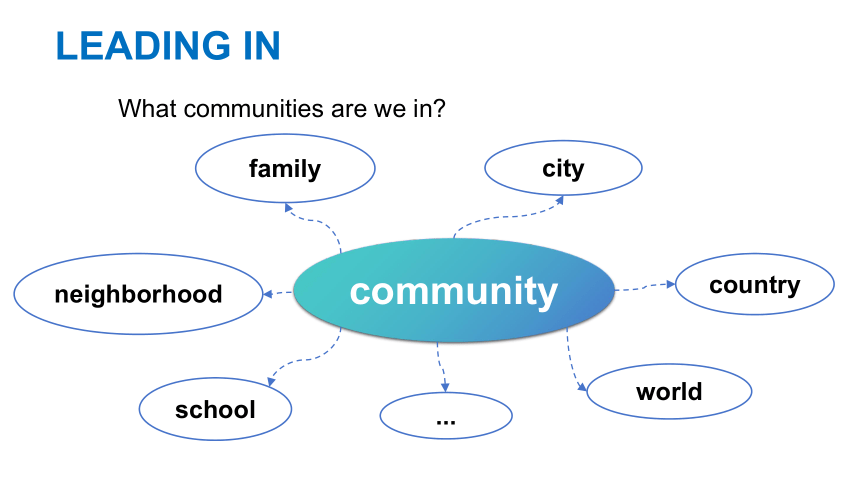

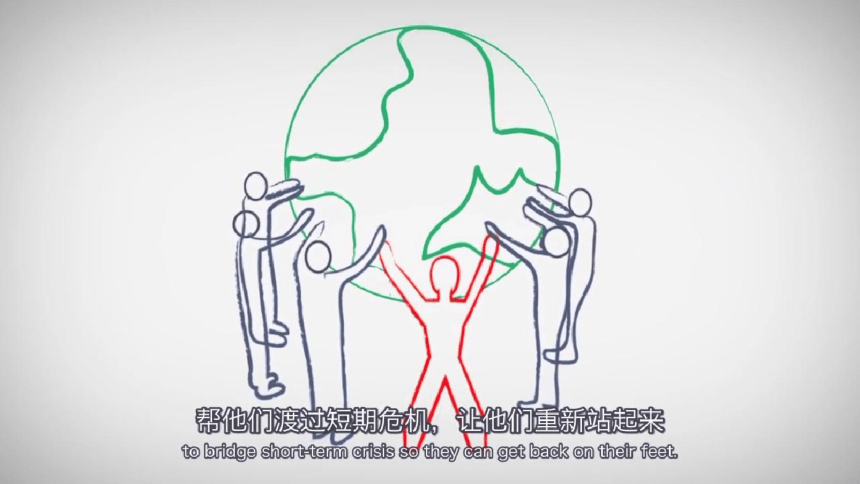
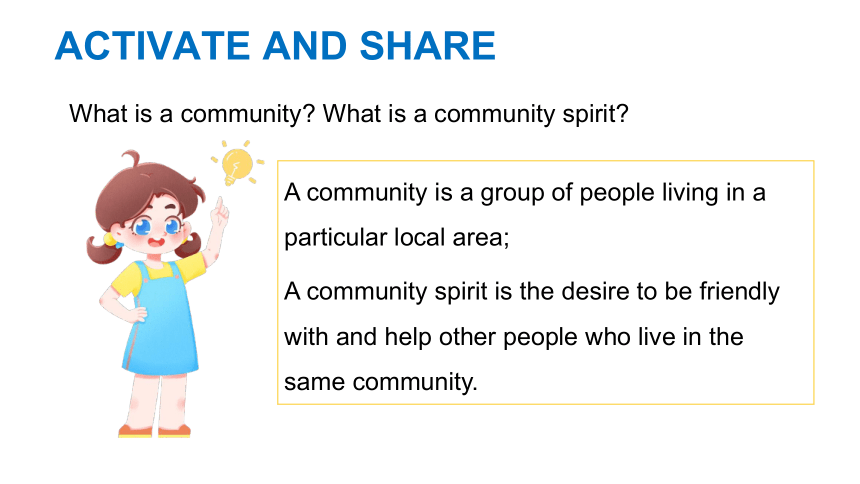
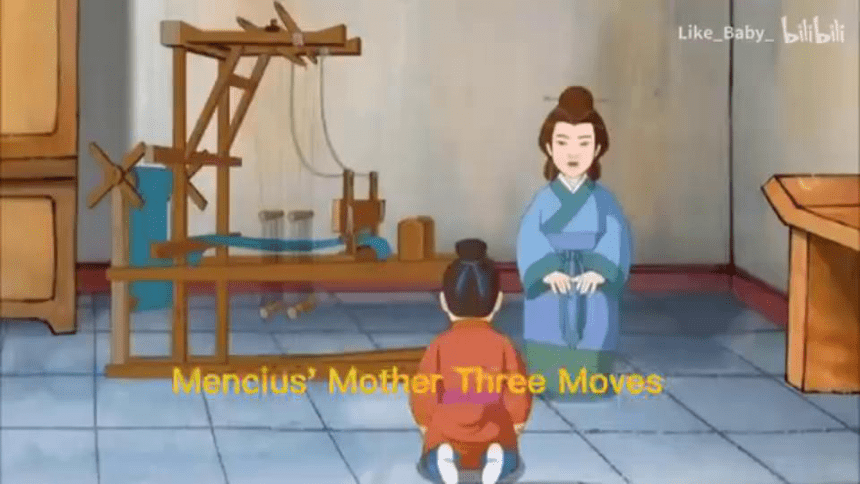
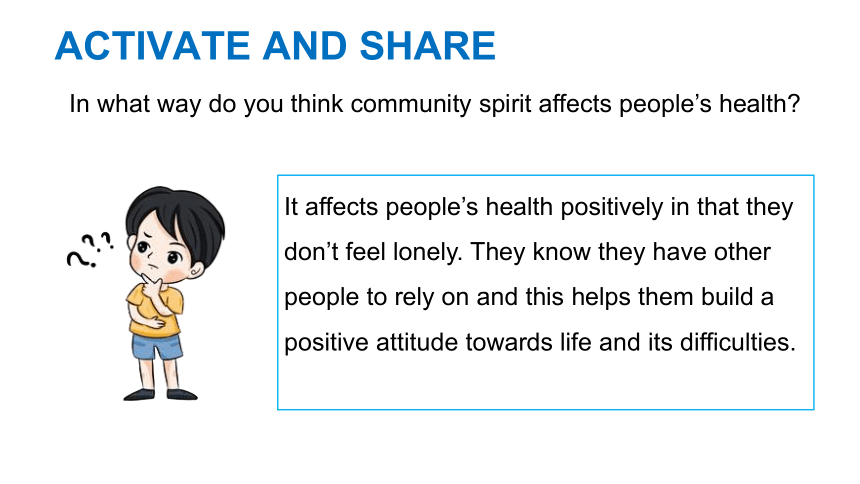
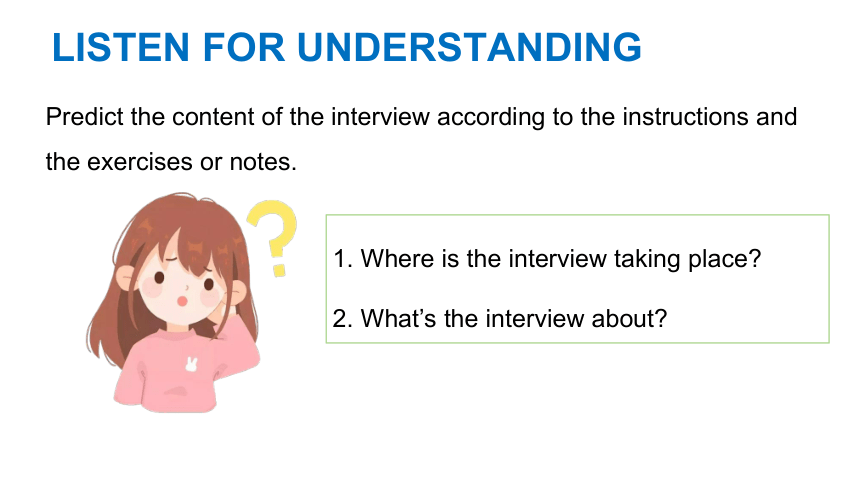
文档简介
(共47张PPT)
LESSON 2
COMMUNITY SPIRIT
UNIT 10 CONNECTIONS
LEARNING OBJECTIVES
To listen and talk about community spirit;
To listen for general understanding;
To listen for specific information and deep understanding;
To recall information previously heard;
To understand and learn words and expressions in context;
To compare personal opinions with the ideas of others;
To practice using vague language.
KEY POINTS AND DIFFICULT POINTS
To understand and discuss community spirit;
To answer the comprehension questions;
To listen for general idea of the text;
To recall key information after listening;
To express personal opinions and exchange ideas with others;
To figure out the purpose we use vague language.
LEADING IN
What is a community
A community is a group of people living in the same area.
--- Merriam-Webster's Dictionary
LEADING IN
What communities are we in
community
family
neighborhood
city
country
school
world
...
ACTIVATE AND SHARE
What is a community What do people do in a community
□ look after each other
□ visit each other
□ organise community celebrations
□ respect elderly people
□ live in single-family houses
□ __________________________
LEADING IN
What is a community
ACTIVATE AND SHARE
What is a community What is a community spirit
A community is a group of people living in a particular local area;
A community spirit is the desire to be friendly with and help other people who live in the same community.
Do you know the story
LEADING IN
ACTIVATE AND SHARE
In what way do you think community spirit affects people’s health
It affects people’s health positively in that they don’t feel lonely. They know they have other people to rely on and this helps them build a positive attitude towards life and its difficulties.
LISTEN FOR UNDERSTANDING
Predict the content of the interview according to the instructions and the exercises or notes.
1. Where is the interview taking place
2. What’s the interview about
LISTEN FOR UNDERSTANDING
Predict the content of the interview according to the instructions and the exercises or notes.
1. Where is the interview taking place
In a radio programme.
2. What’s the interview about
The interview is talking about how the community spirit of a small town called Roseto impacted on the residents’ health.
LISTEN FOR UNDERSTANDING
Dr. Smith is talking about how the community spirit of a small town called Roseto impacted on the residents’ health in a radio programme. Listen and answer the questions.
1. What surprising facts did doctors discover about Rosetans in the 1950s
They discovered that there was hardly a Rosetan below 65 who’d experienced a heart attack.
LISTEN FOR UNDERSTANDING
Dr. Smith is talking about how the community spirit of a small town called Roseto impacted on the residents’ health in a radio programme. Listen and answer the questions.
2. What was the reason for the facts
The reason was that Roseto was a very closely-knit community.
LISTEN FOR UNDERSTANDING
Pair work Listen again. Complete the table about the Roseto community in the 1950s and 1960s. Them talk about what happened to Rosetans in those years.
In the 1950s
Community life was a very ______________ community
looked after each other
_________ each other
frequently organized _________________________
households consisted of _____________________
old people _____________________
community celebrations
closely-knit
visited
three generations
were respected
LISTEN FOR UNDERSTANDING
Pair work Listen again. Complete the table about the Roseto community in the 1950s and 1960s. Them talk about what happened to Rosetans in those years.
In the 1950s
Consequences hardly did a Rosetan below 65
________________________________
people were dying _______________ rather than ______________
very little _________
of old age
from illness
crime
experience a heart attack
LISTEN FOR UNDERSTANDING
Pair work Listen again. Complete the table about the Roseto community in the 1950s and 1960s. Them talk about what happened to Rosetans in those years.
In the 1960s
Community life younger Rosetans would not keep up __________________________
moved to typical ______________________
rejected _________________________
the traditional lifestyles
single-family houses
traditional social bonds
LISTEN FOR UNDERSTANDING
Pair work Listen again. Complete the table about the Roseto community in the 1950s and 1960s. Them talk about what happened to Rosetans in those years.
In the 1960s
Consequences the first heart attack of a Rosetan under 45 happened in ________
the rate of heart attacks is _________________________
the same as the average
1971
TAPESCRIPTS
(I=Interviewer S=Dr. Smith)
I: Good morning, Dr. Smith. Welcome to our programme. We noticed that you have paid quite a few visits to a small town called Roseto. We know that you are involved in a research project there. Would you please tell us more about it
S: Of course. Actually, my research was based on an earlier study of the lifestyle in Roseto. In the 1950s, heart attacks were an epidemic in the USA, but doctors found there was
TAPESCRIPTS
hardly a Rosetan below 65 who’d experienced one. People were dying of old age rather than from illness. Additionally, there was very little crime. This was a very safe small town.
I: That’s amazing. What were the reasons
S: According to an earlier study about Roseto, researchers found that the reason for the low rate of Rosetans’ heart attacks was the community itself. Roseto was a very closely-knit community. People there looked after each
TAPESCRIPTS
other. They visited each other and frequently organised
community celebrations. In Roseto, almost all households consisted of three generations. Old people were respected. The social network they enjoyed protected them from the pressure of the modern world.
I: Then what was the situation in later years
S: In the 1960s, younger Rosetans would not keep up the traditional lifestyle. They moved to typical single-family
TAPESCRIPTS
houses on the outskirts of the town. They rejected traditional social bonds.
I: What has happened since then
S: Well, the consequences of the change followed quickly. The first heart attack of a Rosetan under 45 happened in 1971. Today the rate of heart attacks in Roseto is the same as the average.
I: Wow, that’s surprising ...
LISTEN FOR UNDERSTANDING
What have you learnt about community spirit from the small town of Roseto Answer the questions.
1. How did Rosetans live in the 1950s Why did they have a
low rate of heart attacks at that time
People there looked after each other. They visited each other and frequently organised community celebrations. In Roseto, almost all households consisted of three generations. Old people were respected. The social network they enjoyed protected them from the pressure of the modern world. Because Roseto was a very closely-knit community.
LISTEN FOR UNDERSTANDING
What have you learnt about community spirit from the small town of Roseto Answer the questions.
2. How did the community change in the 1960s What was the result
In the 1960s, young people would not keep up the traditional lifestyle. They moved to typical single-family houses on the outskirts of the town. They rejected traditional social bonds. The first heart attack of a Rosetan under 45 happened in 1971. Today the rate of heart attacks in Rosetans is the same as the average.
LISTEN FOR UNDERSTANDING
What have you learnt about community spirit from the small town of Roseto Answer the questions.
3. What do you think the findings of the research imply Or what can we learn from the findings
The findings imply that closely-knit community help reduce old people’s heart attack rate.
We can learn from the findings that we could build a closely-knit family for the sake of old people.
Linda is talking with her grandpa, trying to find out more about her mother’s hometown. Listen and complete the information.
FOCUS ON FUNCTION: VAGUE LANGUAGE
What is the dialogue about
The dialogue is a conversation between Linda and her grandfather about how life was like in her mother’s hometown.
FOCUS ON FUNCTION: VAGUE LANGUAGE
Linda is talking with her grandpa, trying to find out more about her mother’s hometown. Listen and complete the information.
Mum’s hometown ______________.
There weren’t _____________________.
They didn’t live in flats but in ______________________________________.
The kitchen and toilet were __________________.
were small
a sort of house with two small rooms
many tall buildings
outside the house
Hometown
and living conditions in the past
FOCUS ON FUNCTION: VAGUE LANGUAGE
Linda is talking with her grandpa, trying to find out more about her mother’s hometown. Listen and complete the information.
They were close to __________________.
They were _______________________.
They were just like _____________________.
Children ______________________________.
Neighbours _________________________.
Relationships
with neighbours
their neighbours
friendly to each other
a kind of big family
played together after school
often visited each other
FOCUS ON FUNCTION: VAGUE LANGUAGE
Listen and plete the Talk Builder. What kind of language features can you identify
Vague Language
Similar to something
Mum always tells me her hometown is small, but this is ________ a big city.
like
like
a bit
a kind of
a sort of
FOCUS ON FUNCTION: VAGUE LANGUAGE
Listen and plete the Talk Builder. What kind of language features can you identify
Vague Language
Part of a category
We lived in _____________ house …
We were friendly to each other, just like _______________ big family.
Less in quality
It was ___________ inconvenient.
a sort of
a kind of
a bit
TAPESCRIPTS
(L = Linda G = Grandpa)
L: Mum always tells me her hometown is small, but this is like a big city.
G: Well, it wasn’t like this when your mum was here. Our town was small then. There weren’t many tall buildings. Back then, we didn’t live in flats. We lived in a sort of house, with two small rooms, not like the big houses today. The kitchen and toilet were outside the house. We shared them
TAPESCRIPTS
with our neighbours.
L: That was not convenient, was it
G: No. It was a bit inconvenient, but we didn’t feel that at that time. Actually, we were close to our neighbours. We were friendly to each other, just like a kind of big family.
L: That’s cool. It’s great to live in a closely-knit community.
G: Yes. Children played together after school, and neighbours often visited each other. You know, some old
TAPESCRIPTS
neighbours are still my best friends, although we live far away now.
L: You mean the friends who are coming this afternoon Are they all your old neighbours
G: Yes. You can ask them to tell you your mum’s childhood stories.
L: Great!
FOCUS ON FUNCTION: VAGUE LANGUAGE
For what purpose would you use vague language
purpose
To make a statement less strong.
To make things sound less factual.
When we don’t know the name of something.
To talk about groups and categories.
FOCUS ON FUNCTION: VAGUE LANGUAGE
What have you learned about vague language
Vague language is not totally accurate or clear. Although some people think this is "bad" English all native English speakers use vague language when they are unable or unwilling to give accurate information,or they think it is either unnecessary or socially inappropriate to do so.
SPEAK
Pair Work Introduce the community where you live with as much factual information as possible, using vague language where appropriate.
Living conditions
I live in a community where there are trees all year round. Each family has it’s own private space and you can’t enter without permission. The kitchen and toilet are cleaner than those in the past. Nowadays people take a shower and go to the toilet in the same place called “bathroom”.
SPEAK
Pair Work Introduce the community where you live with as much factual information as possible, using vague language where appropriate.
Relationships with neighbours
We say hi to our neighbours when returning home and going out. Other than that, we barely have a chance to see them. However, there are a lot of community activities for neighbours to bond together.
VOCABULARY
1. consequence
in consequence/as a consequence 因此,所以
in consequence of/as a consequence of 因为,由于
have consequences 产生后果
accept/take/suffer the consequences 承担后果
face the consequences 面对后果
练习:She doesn’t feel like eating anything as a _______________ of her sickness.
consequence
VOCABULARY
2. additionally
in addition“除此之外,另外”,是副词性短语,单独作状语。
in addition to“除……之外(还)”,是短语介词,后接名词、代词或动名词。
add v. 增加 addition n. 增加;加法
additional adj. 附加的,额外的
练习:__________________, you do not have access to the forum freely.
Additionally
VOCABULARY
3. consist of
consist in 在于,存在于(= lie in)
consistent adj. 一致的,始终如一的
be consistent with 与……一致
consists of = be made up of = make up
练习:The scientific research team ________________ ten experts from different provinces.
consists of
LANGUAGE POINTS
1. In Roseto, almost all households consisted of three generations.
household n. 一家人,同住一栋房子的人 adj. 家庭的
Every household in the district is supposed to be proud of their happy life.
该地区的每个家庭都应该为他们的幸福生活而感到自豪。
There are some similarities between the two households.
这两个家庭之间有一些相似之处。
LANGUAGE POINTS
2. They rejected traditional social bonds.
bond
(1)n. 纽带,联系;保释金;结合;枷锁
A bond of friendship has been forged between them.
他们之间形成了一种友谊的纽带。
He was released on $5,000 bond.
他以5000美元取保释放。
a firm bond between the two surfaces 两个面之间的牢固接合
to release sb from their bonds 给某人脱去枷锁
LANGUAGE POINTS
2. They rejected traditional social bonds.
bond
(2)v. 使牢固结合,把……紧紧地连接到;增强(与某人的)信任关系
Being close to nature offers you a chance to bond with your children.
亲近大自然让你有机会和孩子建立(亲密)关系。
Second, the weather allows you to bond with colleagues by giving you a shared interest.
其次,通过给你们一个共同的兴趣,天气可以帮你与同事建立感情。
PRACTICE
1. The true ______________________ (consequences) will only be known several years hence.
2. ______________________ (addition), they should be allowed to teach, and be rewarded for doing it well.
3. The restaurant is upstairs and __________________ (consist) of a large, open room.
4. Once you have built these __________________ (bond), students work together much better.
consequences
Additionally
consists
bonds
SUMMARY
Talk about and learn community spirit;
Get general understanding and specific information;
Learn about and practice words and expressions in context;
Express personal opinions and exchange ideas with others;
Recall key information previously heard;
Practice using vague language;
Figure out the purpose we use vague language.
Thank you
LESSON 2
COMMUNITY SPIRIT
UNIT 10 CONNECTIONS
LEARNING OBJECTIVES
To listen and talk about community spirit;
To listen for general understanding;
To listen for specific information and deep understanding;
To recall information previously heard;
To understand and learn words and expressions in context;
To compare personal opinions with the ideas of others;
To practice using vague language.
KEY POINTS AND DIFFICULT POINTS
To understand and discuss community spirit;
To answer the comprehension questions;
To listen for general idea of the text;
To recall key information after listening;
To express personal opinions and exchange ideas with others;
To figure out the purpose we use vague language.
LEADING IN
What is a community
A community is a group of people living in the same area.
--- Merriam-Webster's Dictionary
LEADING IN
What communities are we in
community
family
neighborhood
city
country
school
world
...
ACTIVATE AND SHARE
What is a community What do people do in a community
□ look after each other
□ visit each other
□ organise community celebrations
□ respect elderly people
□ live in single-family houses
□ __________________________
LEADING IN
What is a community
ACTIVATE AND SHARE
What is a community What is a community spirit
A community is a group of people living in a particular local area;
A community spirit is the desire to be friendly with and help other people who live in the same community.
Do you know the story
LEADING IN
ACTIVATE AND SHARE
In what way do you think community spirit affects people’s health
It affects people’s health positively in that they don’t feel lonely. They know they have other people to rely on and this helps them build a positive attitude towards life and its difficulties.
LISTEN FOR UNDERSTANDING
Predict the content of the interview according to the instructions and the exercises or notes.
1. Where is the interview taking place
2. What’s the interview about
LISTEN FOR UNDERSTANDING
Predict the content of the interview according to the instructions and the exercises or notes.
1. Where is the interview taking place
In a radio programme.
2. What’s the interview about
The interview is talking about how the community spirit of a small town called Roseto impacted on the residents’ health.
LISTEN FOR UNDERSTANDING
Dr. Smith is talking about how the community spirit of a small town called Roseto impacted on the residents’ health in a radio programme. Listen and answer the questions.
1. What surprising facts did doctors discover about Rosetans in the 1950s
They discovered that there was hardly a Rosetan below 65 who’d experienced a heart attack.
LISTEN FOR UNDERSTANDING
Dr. Smith is talking about how the community spirit of a small town called Roseto impacted on the residents’ health in a radio programme. Listen and answer the questions.
2. What was the reason for the facts
The reason was that Roseto was a very closely-knit community.
LISTEN FOR UNDERSTANDING
Pair work Listen again. Complete the table about the Roseto community in the 1950s and 1960s. Them talk about what happened to Rosetans in those years.
In the 1950s
Community life was a very ______________ community
looked after each other
_________ each other
frequently organized _________________________
households consisted of _____________________
old people _____________________
community celebrations
closely-knit
visited
three generations
were respected
LISTEN FOR UNDERSTANDING
Pair work Listen again. Complete the table about the Roseto community in the 1950s and 1960s. Them talk about what happened to Rosetans in those years.
In the 1950s
Consequences hardly did a Rosetan below 65
________________________________
people were dying _______________ rather than ______________
very little _________
of old age
from illness
crime
experience a heart attack
LISTEN FOR UNDERSTANDING
Pair work Listen again. Complete the table about the Roseto community in the 1950s and 1960s. Them talk about what happened to Rosetans in those years.
In the 1960s
Community life younger Rosetans would not keep up __________________________
moved to typical ______________________
rejected _________________________
the traditional lifestyles
single-family houses
traditional social bonds
LISTEN FOR UNDERSTANDING
Pair work Listen again. Complete the table about the Roseto community in the 1950s and 1960s. Them talk about what happened to Rosetans in those years.
In the 1960s
Consequences the first heart attack of a Rosetan under 45 happened in ________
the rate of heart attacks is _________________________
the same as the average
1971
TAPESCRIPTS
(I=Interviewer S=Dr. Smith)
I: Good morning, Dr. Smith. Welcome to our programme. We noticed that you have paid quite a few visits to a small town called Roseto. We know that you are involved in a research project there. Would you please tell us more about it
S: Of course. Actually, my research was based on an earlier study of the lifestyle in Roseto. In the 1950s, heart attacks were an epidemic in the USA, but doctors found there was
TAPESCRIPTS
hardly a Rosetan below 65 who’d experienced one. People were dying of old age rather than from illness. Additionally, there was very little crime. This was a very safe small town.
I: That’s amazing. What were the reasons
S: According to an earlier study about Roseto, researchers found that the reason for the low rate of Rosetans’ heart attacks was the community itself. Roseto was a very closely-knit community. People there looked after each
TAPESCRIPTS
other. They visited each other and frequently organised
community celebrations. In Roseto, almost all households consisted of three generations. Old people were respected. The social network they enjoyed protected them from the pressure of the modern world.
I: Then what was the situation in later years
S: In the 1960s, younger Rosetans would not keep up the traditional lifestyle. They moved to typical single-family
TAPESCRIPTS
houses on the outskirts of the town. They rejected traditional social bonds.
I: What has happened since then
S: Well, the consequences of the change followed quickly. The first heart attack of a Rosetan under 45 happened in 1971. Today the rate of heart attacks in Roseto is the same as the average.
I: Wow, that’s surprising ...
LISTEN FOR UNDERSTANDING
What have you learnt about community spirit from the small town of Roseto Answer the questions.
1. How did Rosetans live in the 1950s Why did they have a
low rate of heart attacks at that time
People there looked after each other. They visited each other and frequently organised community celebrations. In Roseto, almost all households consisted of three generations. Old people were respected. The social network they enjoyed protected them from the pressure of the modern world. Because Roseto was a very closely-knit community.
LISTEN FOR UNDERSTANDING
What have you learnt about community spirit from the small town of Roseto Answer the questions.
2. How did the community change in the 1960s What was the result
In the 1960s, young people would not keep up the traditional lifestyle. They moved to typical single-family houses on the outskirts of the town. They rejected traditional social bonds. The first heart attack of a Rosetan under 45 happened in 1971. Today the rate of heart attacks in Rosetans is the same as the average.
LISTEN FOR UNDERSTANDING
What have you learnt about community spirit from the small town of Roseto Answer the questions.
3. What do you think the findings of the research imply Or what can we learn from the findings
The findings imply that closely-knit community help reduce old people’s heart attack rate.
We can learn from the findings that we could build a closely-knit family for the sake of old people.
Linda is talking with her grandpa, trying to find out more about her mother’s hometown. Listen and complete the information.
FOCUS ON FUNCTION: VAGUE LANGUAGE
What is the dialogue about
The dialogue is a conversation between Linda and her grandfather about how life was like in her mother’s hometown.
FOCUS ON FUNCTION: VAGUE LANGUAGE
Linda is talking with her grandpa, trying to find out more about her mother’s hometown. Listen and complete the information.
Mum’s hometown ______________.
There weren’t _____________________.
They didn’t live in flats but in ______________________________________.
The kitchen and toilet were __________________.
were small
a sort of house with two small rooms
many tall buildings
outside the house
Hometown
and living conditions in the past
FOCUS ON FUNCTION: VAGUE LANGUAGE
Linda is talking with her grandpa, trying to find out more about her mother’s hometown. Listen and complete the information.
They were close to __________________.
They were _______________________.
They were just like _____________________.
Children ______________________________.
Neighbours _________________________.
Relationships
with neighbours
their neighbours
friendly to each other
a kind of big family
played together after school
often visited each other
FOCUS ON FUNCTION: VAGUE LANGUAGE
Listen and plete the Talk Builder. What kind of language features can you identify
Vague Language
Similar to something
Mum always tells me her hometown is small, but this is ________ a big city.
like
like
a bit
a kind of
a sort of
FOCUS ON FUNCTION: VAGUE LANGUAGE
Listen and plete the Talk Builder. What kind of language features can you identify
Vague Language
Part of a category
We lived in _____________ house …
We were friendly to each other, just like _______________ big family.
Less in quality
It was ___________ inconvenient.
a sort of
a kind of
a bit
TAPESCRIPTS
(L = Linda G = Grandpa)
L: Mum always tells me her hometown is small, but this is like a big city.
G: Well, it wasn’t like this when your mum was here. Our town was small then. There weren’t many tall buildings. Back then, we didn’t live in flats. We lived in a sort of house, with two small rooms, not like the big houses today. The kitchen and toilet were outside the house. We shared them
TAPESCRIPTS
with our neighbours.
L: That was not convenient, was it
G: No. It was a bit inconvenient, but we didn’t feel that at that time. Actually, we were close to our neighbours. We were friendly to each other, just like a kind of big family.
L: That’s cool. It’s great to live in a closely-knit community.
G: Yes. Children played together after school, and neighbours often visited each other. You know, some old
TAPESCRIPTS
neighbours are still my best friends, although we live far away now.
L: You mean the friends who are coming this afternoon Are they all your old neighbours
G: Yes. You can ask them to tell you your mum’s childhood stories.
L: Great!
FOCUS ON FUNCTION: VAGUE LANGUAGE
For what purpose would you use vague language
purpose
To make a statement less strong.
To make things sound less factual.
When we don’t know the name of something.
To talk about groups and categories.
FOCUS ON FUNCTION: VAGUE LANGUAGE
What have you learned about vague language
Vague language is not totally accurate or clear. Although some people think this is "bad" English all native English speakers use vague language when they are unable or unwilling to give accurate information,or they think it is either unnecessary or socially inappropriate to do so.
SPEAK
Pair Work Introduce the community where you live with as much factual information as possible, using vague language where appropriate.
Living conditions
I live in a community where there are trees all year round. Each family has it’s own private space and you can’t enter without permission. The kitchen and toilet are cleaner than those in the past. Nowadays people take a shower and go to the toilet in the same place called “bathroom”.
SPEAK
Pair Work Introduce the community where you live with as much factual information as possible, using vague language where appropriate.
Relationships with neighbours
We say hi to our neighbours when returning home and going out. Other than that, we barely have a chance to see them. However, there are a lot of community activities for neighbours to bond together.
VOCABULARY
1. consequence
in consequence/as a consequence 因此,所以
in consequence of/as a consequence of 因为,由于
have consequences 产生后果
accept/take/suffer the consequences 承担后果
face the consequences 面对后果
练习:She doesn’t feel like eating anything as a _______________ of her sickness.
consequence
VOCABULARY
2. additionally
in addition“除此之外,另外”,是副词性短语,单独作状语。
in addition to“除……之外(还)”,是短语介词,后接名词、代词或动名词。
add v. 增加 addition n. 增加;加法
additional adj. 附加的,额外的
练习:__________________, you do not have access to the forum freely.
Additionally
VOCABULARY
3. consist of
consist in 在于,存在于(= lie in)
consistent adj. 一致的,始终如一的
be consistent with 与……一致
consists of = be made up of = make up
练习:The scientific research team ________________ ten experts from different provinces.
consists of
LANGUAGE POINTS
1. In Roseto, almost all households consisted of three generations.
household n. 一家人,同住一栋房子的人 adj. 家庭的
Every household in the district is supposed to be proud of their happy life.
该地区的每个家庭都应该为他们的幸福生活而感到自豪。
There are some similarities between the two households.
这两个家庭之间有一些相似之处。
LANGUAGE POINTS
2. They rejected traditional social bonds.
bond
(1)n. 纽带,联系;保释金;结合;枷锁
A bond of friendship has been forged between them.
他们之间形成了一种友谊的纽带。
He was released on $5,000 bond.
他以5000美元取保释放。
a firm bond between the two surfaces 两个面之间的牢固接合
to release sb from their bonds 给某人脱去枷锁
LANGUAGE POINTS
2. They rejected traditional social bonds.
bond
(2)v. 使牢固结合,把……紧紧地连接到;增强(与某人的)信任关系
Being close to nature offers you a chance to bond with your children.
亲近大自然让你有机会和孩子建立(亲密)关系。
Second, the weather allows you to bond with colleagues by giving you a shared interest.
其次,通过给你们一个共同的兴趣,天气可以帮你与同事建立感情。
PRACTICE
1. The true ______________________ (consequences) will only be known several years hence.
2. ______________________ (addition), they should be allowed to teach, and be rewarded for doing it well.
3. The restaurant is upstairs and __________________ (consist) of a large, open room.
4. Once you have built these __________________ (bond), students work together much better.
consequences
Additionally
consists
bonds
SUMMARY
Talk about and learn community spirit;
Get general understanding and specific information;
Learn about and practice words and expressions in context;
Express personal opinions and exchange ideas with others;
Recall key information previously heard;
Practice using vague language;
Figure out the purpose we use vague language.
Thank you
同课章节目录
- Unit 10 Connections
- Lesson 1 How Closely Connected Are We?
- Lesson 2 Community Spirit
- Lesson 3 Anne of Green Gables
- Unit 11 Conflict And Compromise
- Lesson 1 Living In a Community
- Lesson 2 Dealing with Conflict
- Lesson 3 War Memories
- Unit 12 Innovation
- Lesson 1 Scientific Breakthroughs
- Lesson 2 Aha Moment
- Lesson 3 Stephen Hawking
